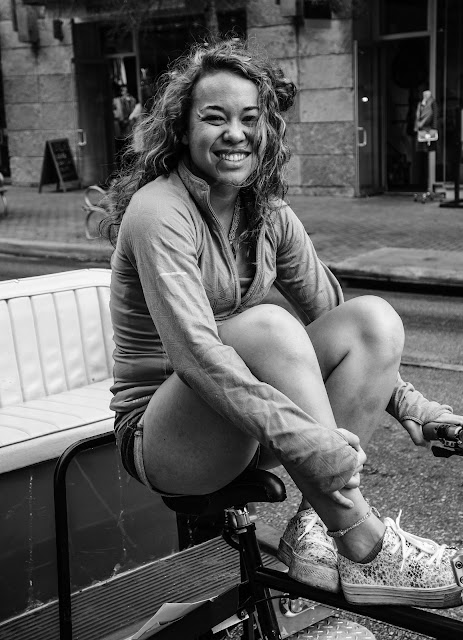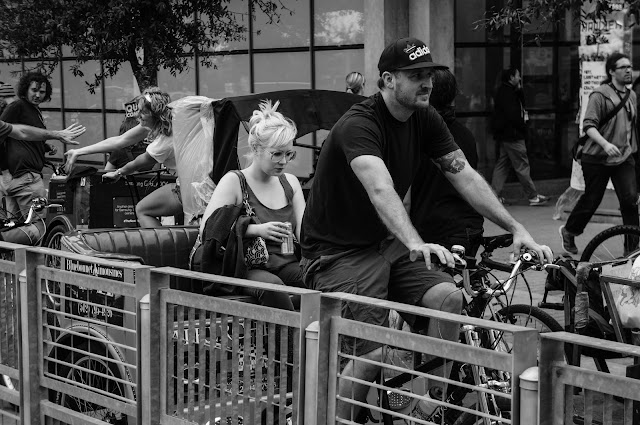World's finest portrait lens? Or my own personal crutch?
I had an assignment yesterday to go to an office on the 26th floor of a very nice building and make portraits of three men. I had shot in the office space before and had taken advantage of the beautiful, indirect light coming through the floor to ceiling windows on the north side of the building. The architecture in the space is very modern, with lots of clean lines and interesting diagonals. The method that worked best for me the last time I shot there was to use the natural light from a three quarters angle and add the barest touch of fill light to add some spark to the image and a nice catchlight in subjects' eyes. I knew I wanted to shoot fairly long and to drop the background out of focus so the lines all softened and created a contrast in sharp and soft between my subjects' faces and the shapes in the background.
When I last shot there I was using the Nikon D7100 and the Samsung NX30 with each makers 85mm lenses. The 128mm equivalent focal length (when compared to a lens on a full 35mm frame camera) was just a bit too long and a bit too compressed on the APS-C cameras to be visually comfortable for me. There was a friction between the tools I had and the vision in my head. I wasn't close enough for a really effective (and quiet) rapport when I got to a distance that allowed me to shoot with the composition and head sizes I wanted. The images were fine but it always bothered me that I couldn't quite get exactly what I wanted.
In anticipation of yesterday's assignment I rummaged through the drawer full of Nikon stuff in the studio and dutifully loaded the 80-200mm f2.8 zoom, the 85mm f1.8, the Sigma 50 Art lens and even a 24-85mm zoom. Almost as an afterthought I also grabbed the diminutive Nikon 105mm f2.5 ais lens. It had served me well on a similar assignment last week during which I got over any fears of manual focusing this lens on the D610 and D810 cameras.
The Nikon 105mm f2.5 is a five element lens with four groups that seems to me to mark the high point of quality among affordable, non-esoteric lenses that people can actually afford and would actually want to shoot with. It is dense with glass and metal and the focusing ring of this aging optic makes the "fly-by-wire" focusing rings of most autofocus lenses feel cheesy and toy-like. Since it is an Ai (auto indexing) lens it works in aperture priority and manual exposure modes, with full metering, on any current (or recent) professional Nikon cameras, including APS-C cameras like the D7000, the D7100 and the D7200. It also works with any of the full frame cameras, as well.
I set up my camera on a tripod with a giant wall of windows to my left and the subject in the middle of a wide space, turned 45 degrees toward the window. On the shadow side were pure white walls which made for good natural fill. I used a new flash and flash trigger that the people at Cactus sent me to test. The flash is the RF60 and the radio trigger is the V6. I set the flash onto a light stand with an umbrella stand adapter and a 48 inch white umbrella. The fun feature of this flash and radio trigger combination is that one can control the manual power settings of the flash from the camera position via the trigger mechanism. I was able to keep dialing down the flash power until its effect was very subtle but very effective in cleaning up the portrait image and adding catch light. This rig was portable enough to bring along in my rolling case and takes about a minute to set up. At 1/32nd power the flash could sit there and pop all day long. I only needed the system to do so about 220 times.
Once I had the balance of light the way I wanted it I concentrated on comping my shot and getting just the right camera to subject distance to give me enough person for context but a shallow enough depth of field to make the background soft and unobtrusive. I used f2.8 for all of the waist up, horizontally framed shots and I dropped down to f4.0 for a little deeper focus with the tighter "chest and head" portraits with each person. This made fine focusing critical. I've been reticent to trust the focusing screens on the camera since I could never sharply focus any manual lens on the D7100 or D7000s I had. I would always double check by going to live view and punching in on the magnification.
I did that a lot last week but every time I checked the magnified view matched what I was seeing in the finder and also matched up with the green confirmation dot in the finder of both of the D610s and the D810. Yesterday I put the 105mm on the Nikon D610. I recently put a +2.0 diopter on the eyepiece to bring the correction on the dial back to zero for my eyes. It seems to have made a difference for me in how well I can see focus on the screen.
I did the live view mag. confirm focus thing a couple of times and then I became reasonably convinced that I had finally mastered manual focus with this body. The images were just as I imagined them when I looked at them with my naked eyes. The tonality of the lens and the dynamic range of the camera sensor added up to portraits that were convincingly sharp when zooming into my subjects' eyes but without the harsh sharpness that sometimes plagues newer (amped up) glass.
When I did my first round of post production there were only three images I needed to trash because of focus problems. The the colors, textures and general feel of the images was just what I wanted. The lens isn't quite as contrasty as more current lenses but that's a very simple thing to fine tune in post processing. And while the broad contrast is lower the micro-contrast is highly competitive. Maybe it's this reverse application of contrast qualities that makes this lens such a spectacular portrait lens...
At any rate, when I finished shooting I was so enthralled with the overall performance of the lens and the cameras in combination that I searched KEH.com and ordered a second one. I bought another late model Ais (the last version made) in excellent condition and it should arrive next week.
Why on earth would you buy a second one?
My answer? The lens has a particular look and feel. It's not made anymore. The supply will eventually either dry up or become much more expensive. If this lens really is the sweet spot for my particular vision of portraits is the small, extra expenditure to ensure access to its unique set of features wasteful or wise? I vote wise.
Edit: The additional copy of the lens arrived today from KEH (three days quicker than they promised) and it is absolutely perfect. I can hardly wait to shoot an interview with it.


















































